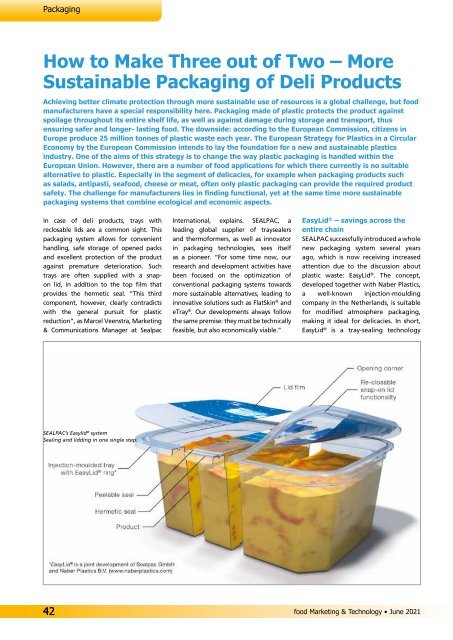food Marketing & Technology 3/2021
You also want an ePaper? Increase the reach of your titles
YUMPU automatically turns print PDFs into web optimized ePapers that Google loves.
Packaging<br />
How to Make Three out of Two – More<br />
Sustainable Packaging of Deli Products<br />
Achieving better climate protection through more sustainable use of resources is a global challenge, but <strong>food</strong><br />
manufacturers have a special responsibility here. Packaging made of plastic protects the product against<br />
spoilage throughout its entire shelf life, as well as against damage during storage and transport, thus<br />
ensuring safer and longer- lasting <strong>food</strong>. The downside: according to the European Commission, citizens in<br />
Europe produce 25 million tonnes of plastic waste each year. The European Strategy for Plastics in a Circular<br />
Economy by the European Commission intends to lay the foundation for a new and sustainable plastics<br />
industry. One of the aims of this strategy is to change the way plastic packaging is handled within the<br />
European Union. However, there are a number of <strong>food</strong> applications for which there currently is no suitable<br />
alternative to plastic. Especially in the segment of delicacies, for example when packaging products such<br />
as salads, antipasti, sea<strong>food</strong>, cheese or meat, often only plastic packaging can provide the required product<br />
safety. The challenge for manufacturers lies in finding functional, yet at the same time more sustainable<br />
packaging systems that combine ecological and economic aspects.<br />
In case of deli products, trays with<br />
reclosable lids are a common sight. This<br />
packaging system allows for convenient<br />
handling, safe storage of opened packs<br />
and excellent protection of the product<br />
against premature deterioration. Such<br />
trays are often supplied with a snapon<br />
lid, in addition to the top film that<br />
provides the hermetic seal. “This third<br />
component, however, clearly contradicts<br />
with the general pursuit for plastic<br />
reduction”, as Marcel Veenstra, <strong>Marketing</strong><br />
& Communications Manager at Sealpac<br />
International, explains. SEALPAC, a<br />
leading global supplier of traysealers<br />
and thermoformers, as well as innovator<br />
in packaging technologies, sees itself<br />
as a pioneer. “For some time now, our<br />
research and development activities have<br />
been focused on the optimization of<br />
conventional packaging systems towards<br />
more sustainable alternatives, leading to<br />
innovative solutions such as FlatSkin ® and<br />
eTray ® . Our developments always follow<br />
the same premise: they must be technically<br />
feasible, but also economically viable.”<br />
EasyLid ® – savings across the<br />
entire chain<br />
SEALPAC successfully introduced a whole<br />
new packaging system several years<br />
ago, which is now receiving increased<br />
attention due to the discussion about<br />
plastic waste: EasyLid ® . The concept,<br />
developed together with Naber Plastics,<br />
a well-known injection-moulding<br />
company in the Netherlands, is suitable<br />
for modified atmosphere packaging,<br />
making it ideal for delicacies. In short,<br />
EasyLid ® is a tray-sealing technology<br />
SEALPAC’s Easylid ® system<br />
Sealing and lidding in one single step.<br />
42<br />
<strong>food</strong> <strong>Marketing</strong> & <strong>Technology</strong> • June <strong>2021</strong>


















